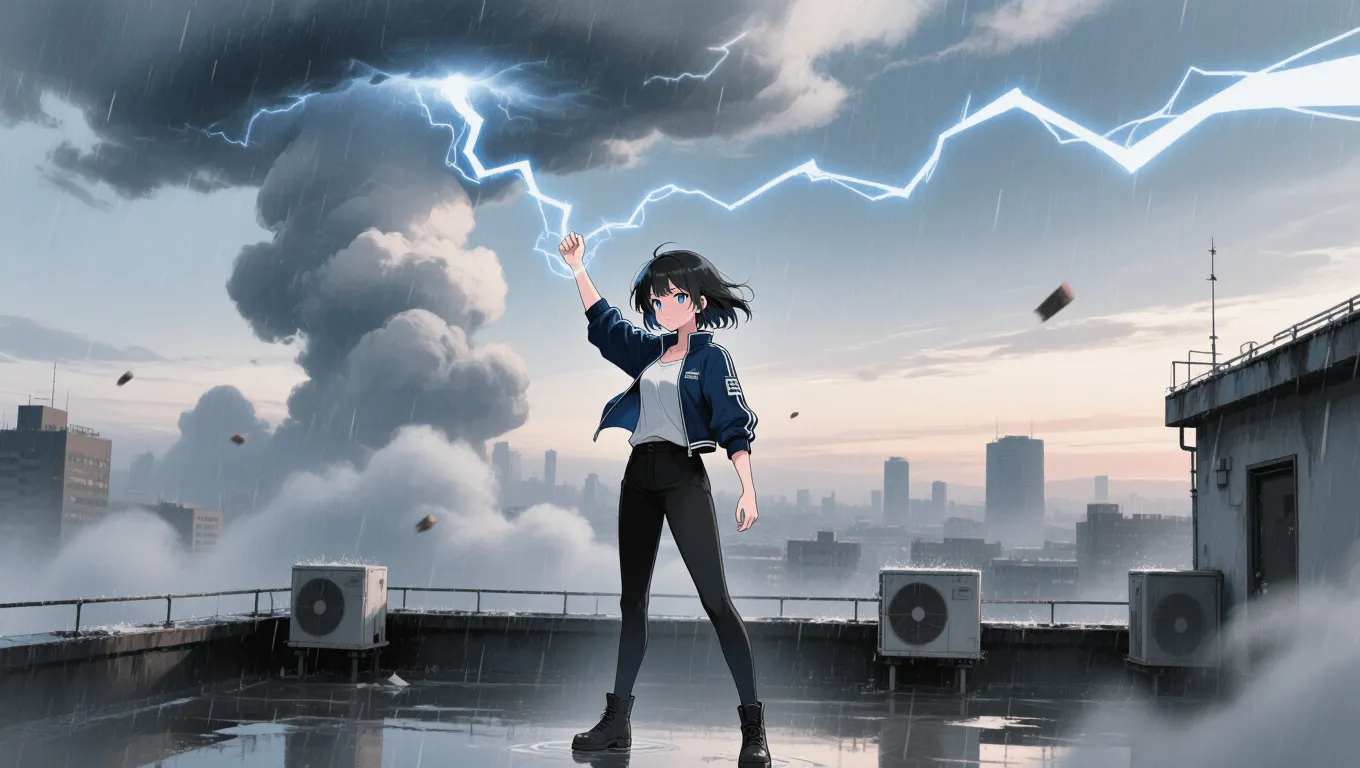Thunderstorm Summoning

Thunderstorm Summoning Video Demo 🎬
Table of Contents
- Thunderstorm Summoning Video Demo 🎬
- What Is Thunderstorm Summoning
- Core Abilities of Thunderstorm Summoning
- Application / Tactical Advantages in Combat
- Level: Level 1 🏙️, Level 2 🌇, Level 3 🌃
- Limitations of Using the Thunderstorm Summoning
- Weakness Against What Other Superpowers
- Synergistic Power Combos
- Known Users
What Is Thunderstorm Summoning
Thunderstorm Summoning is the superpower to call, shape, and sustain a full thunderstorm system on command. Users manipulate atmospheric dynamics—heat, moisture, and pressure—to generate towering cumulonimbus clouds, trigger cloud-to-ground lightning, and unleash coordinated wind, rain, and thunder. This ability sits under advanced weather manipulation and atmokinesis, blending elements of lightning summoning, precipitation control, and wind shear management. On a battlefield, a skilled stormcaller can shift local barometric pressure, seed updrafts and downdrafts, and guide a stormfront like a living weapon. For a broader view of related powers, see the full superpower wiki, or roll a new idea with the random superpower generator.
Core Abilities of Thunderstorm Summoning
Controlled Cumulonimbus Formation
The user accelerates the creation of thunderheads by drawing warm, moist air upward and cooling it rapidly at altitude. By shaping updrafts and regulating latent heat release, they can “grow” a storm vertically until it reaches the anvil stage. This orchestrated cumulonimbus formation is the backbone of thunderstorm control.
Lightning Summoning and Direction
At the storm’s peak, the user manipulates charge separation and ionization pathways to call bolts on demand. They can redirect electrical discharge toward targets, induce cloud-to-ground, cloud-to-cloud, or even bead lightning, and modulate amperage for stunning versus destructive strikes.
Rainfall and Hail Management
Precipitation control lets the user open or throttle the storm’s faucet. Fine-tuning droplet coalescence and ice nucleation can produce soaking rain, sleet, or hail. In rescue scenarios, they can deliver gentle, sustained rainfall; in combat, they can release blinding sheets or localized hail bursts.
Wind Shear and Gust Fronts
By reshaping pressure gradients, a stormcaller adjusts wind fields: microbursts for crowd control, steady crosswinds to hamper aerial foes, or a rolling gust front to push enemies back. This blends aspects of aerokinesis with full-system storm dynamics.
Acoustic and Visual Command
Thunder modulation enables battlefield intimidation and disorientation. The user can stagger thunderclaps to mask movement or create rolling peals that induce panic. Lightning cadence becomes a visual metronome, signaling allies or dazing opponents with timed flashes.
Storm Tracking and Mobility
A practiced wielder “locks onto” a storm cell, guiding its movement along preferred isobars. They can hold the cell stationary over a target or “walk” it across a city block, maintaining cohesion despite competing winds.
Safety Envelope Creation
Advanced users establish a protective buffer, diverting stray strikes and shedding excess charge so allies remain safe beneath the storm canopy.
Application / Tactical Advantages in Combat
Area Denial and Zone Control
A controlled thunderstorm reshapes the battlefield. Torrential rain reduces visibility, wind shear destabilizes flight, and muddy terrain impedes ground units. The user can box opponents into corridors with gust fronts and saturate escape routes with lightning nets.
Precision Strikes with Electrical Overmatch
Directed lightning neutralizes electronics, disables armored suits, and short-circuits energy shields susceptible to EMP-like surges. Short, low-amperage arcs deliver nonlethal takedowns; high-amperage bolts crack defenses and force surrenders.
Anti-Air and Anti-Drone Superiority
Crosswinds, updrafts, and icing conditions devastate drones and hinder winged combatants. Cloud-to-air arcs act as aerial tripwires. Thunder timing wrecks sensor arrays, while rain scatter degrades targeting systems.
Crowd Disruption Without Lasting Damage
Sheet rain and thunderblasts scatter groups while minimizing permanent harm. Visibility management enables stealthy repositioning for allied operatives.
Environmental Support and Rescue
Outside combat, the user can relieve drought-stricken zones with controlled precipitation or cool heatwaves via evaporative cooling. They can also dissipate uncontrolled storms by bleeding energy from turbulent cells.
Level: Level 1 🏙️, Level 2 🌇, Level 3 🌃
Level 1 — Stormcaller Initiate
At entry level, the user can nudge weather already trending stormy. They accelerate cloud buildup on humid days, call occasional lightning from developing cells, and produce localized showers. Control radius is a city block, and effects last minutes. Precision is moderate: single-target arcs are possible but require line-of-sight and clear focus. Fatigue sets in quickly, and collateral wind effects are mild.

Typical Feats
-
Darkening skies and rumbling thunder to distract foes
-
One or two accurate lightning strikes within 100–200 meters
-
Gusts strong enough to push light objects and disrupt aim
Level 2 — Tempest Architect
Now the user can grow a thunderstorm from neutral conditions by synthesizing updrafts and moisture convergence. They juggle lightning cadence, rainfall intensity, and wind profiles simultaneously. Control radius expands to multiple city blocks; duration reaches half an hour with recovery breaks. They can “park” a storm over a target and redirect 50–70% of spontaneous strikes away from allies.

Typical Feats
-
Sustained rain curtains for visibility denial
-
Coordinated cloud-to-ground arcs that bracket moving vehicles
-
Gust fronts that herd enemies toward chokepoints
-
Limited hail formation for armor-denting salvos
Level 3 — Stormfront Sovereign
At mastery, the user commands mesoscale dynamics. They can assemble a supercell under the right conditions, carve eyewall-like clearings, and establish robust safety envelopes. Control extends across a district, with endurance measured in hours if ambient moisture and heat cooperate. Lightning precision is surgical—even through partial cover—by pre-ionizing pathways. They can split or merge cells, dissipate smaller storms, and ride isobars to move the system like a chess piece.

Typical Feats
-
Lightning grids that disable mech battalions or drone swarms
-
Stationary downpours for firefighting or riot de-escalation
-
Microburst “hammers” against fortifications
-
Rapid storm shutdown to prevent collateral flooding
Limitations of Using the Thunderstorm Summoning
Environmental Preconditions
Even the strongest stormcallers are bounded by thermodynamics. Dry, cool, and stable air limits cumulonimbus formation. In deserts at night or polar winters, generating a full thunderstorm is energy-intensive and often impractical.
Energy and Focus Costs
Shaping convection requires sustained concentration. Overextension leads to storm wobble: unintended lightning, wind bursts, or rain shifts. Long engagements risk cognitive overload, turning precise stormcalling into chaotic weather.
Line-of-Sight and Range Considerations
While lightning can be guided, precise targeting is easiest with visual confirmation or a clear sensory lock. Dense structures or underground targets are hard to reach. Range drops with decreasing ambient humidity and temperature.
Collateral Risk
Flash flooding, infrastructure damage, and accidental strikes are real dangers. Ethical stormcallers learn to channel runoff to safe basins and to throttle strike density near civilian zones.
Electromagnetic Interference
Friendly electronics may suffer. Communications and sensors can degrade inside the storm, requiring hardened gear or prearranged hand signals.
Weakness Against What Other Superpowers
Thermokinesis (Heat or Cold) Specialists
Direct heat manipulation can cap convective towers or evaporate low-level moisture, starving the storm. Extreme cold users can over-stabilize the boundary layer, smothering updrafts before they mature.
Vacuum or Pressure Control
Barometric manipulation that flattens gradients will unravel storm structure, dispersing clouds and neutralizing wind shear advantages.
Weather Nullification / Anti-Atmokinesis
Powers that cancel or dampen atmospheric variability blunt thunderstorm control, reducing it to sporadic rain and weak gusts.
Electromagnetic Absorption and Grounding
Lightning-focused strategies falter against users who absorb or redirect electrical energy safely into the ground or into capacitive reservoirs, negating damage and EMP-like effects.
Terraforming and Barrier Domes
Geokinetic domes, force fields, or energy canopies can deflect wind and rain, isolate targets from ionization channels, and reduce strike efficacy.
Synergistic Power Combos
Aerokinesis + Thunderstorm Summoning
Fine-grained wind control stabilizes the storm’s inflow and outflow, enabling tighter lightning placement and longer-lived cells. Aerokinetics can also sculpt gust fronts into moving walls.
Hydrokinesis + Stormcalling
Moisture gathering primes the pump in dry zones. Hydrokinesis can also channel runoff away from allies and prevent flash floods during prolonged engagements.
Electrokinetics + Lightning Guidance
An electrokinetic partner refines current amplitude and waveform, enabling specialized effects: stun-only arcs, EMP bursts, or armor-piercing lances without collateral splintering.
Cryokinesis for Hailcraft
Ice nucleation support produces controlled hail for anti-vehicle barrages while keeping sizes below destructive thresholds when collateral damage must be minimized.
Seismic or Terrain Control
Shaping the ground harvests rain into trenches, moats, or turbines, turning the storm’s water and wind into tactical infrastructure.
Precognition or Enhanced Sensory Suites
Storm tracking becomes preemptive: predicting foe movement and aligning lightning grids in advance, maximizing hit probability.
Known Users
-
Ororo Munroe (Storm) — A premier weather manipulator known for masterful stormcalling and atmospheric control. See her profile on the Marvel Database.
-
Thor Odinson — Wields command over thunder and lightning, often channeling storms as extensions of divine power.
-
Black Adam — Frequently depicted calling lightning and thunder as part of his magical arsenal.
-
Raiden — The thunder god archetype in various media, emblematic of directed lightning and storm dominance.
For readers mapping this ability within a broader taxonomy, explore adjacent entries like lightning manipulation, precipitation control, and full-spectrum atmokinesis in the Superpower Wiki index, or discover a fresh idea with a spin on the random generator.
